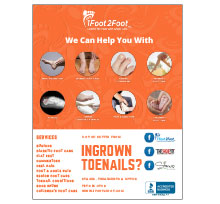Table of Contents
Ingrown Toenails - Introduction
Ingrown toenails are a common ailment where the toenail grows into the skin on the corner or side of your toe. Ingrown toenails cause pain and swelling and if not treated, can lead to painful infections. While they can occur on any toe, the big toe is most commonly the affected toe. While some ingrown toenails can be taken care of at home, it is wise to see a doctor to prevent complications and relieve pain. Diabetics and those with poor blood flow are at an increased risk of complications from ingrown toenails.
Symptoms of Ingrown Toenails
Causes of Ingrown Toenails
Complications
Treatment of Ingrown Toenails
Prevention of Ingrown Toenails
Much of the prevention of ingrown toenails has to do with the way you trim your toenails and the fit of your shoes. Make sure you trim your toenails straight across, not curved to match the shape of your toe. Trim nails so that they are even with the tip of your toes. If you trim your toenails too short, the pressure from walking in shoes may encourage the nail to grow into the tissue. Properly fitting footwear, including shoes, socks, and stockings are a must. Shoes need to be the correct width and length as to not crowd the toes. If you have the potential for toe trauma, either due to work or sport, find appropriate protective footwear. If you have diabetes or other health problems that cause low blood flow to the feet, check your feet daily to make sure that there are no issues with the nails. If you can not reach your feet to trim the nails, make an appointment for a professional trim.







